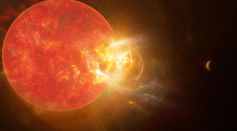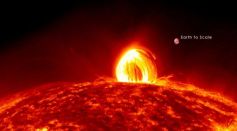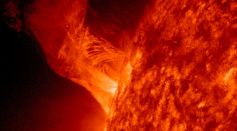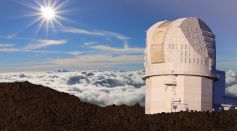Tags: Solar Flare
Solar Flare Effects: What Is the Impact of Geomagnetic Storms on Earth's Field?

Solar Flare From Sun Might Be Heading to Earth; Should We Worry?

Nearby Star Resembles Young Version of Sun; Could Shed Light on How Life Began on Earth
Coronal Mass Ejection Caught on NASA Video Dispersing Billions of Hypersonic Particles, Watch Now!

Solar Storm Heading Towards Earth Likely to Hit Soon; How Does It Affect Someone's Health?

Largest X-Class Solar Flare: Why It is Impossible for "Killer Solar Flare" to Destroy Earth
Coronal Mass Ejection Sends Solar Storm to Earth's Atmosphere, Astronomers Reveal

How Does Solar Eruption Look Like? Here's the Description of NASA's Solar Orbiter

NASA Detects Sunspots as Sprays of Plasma Formed on the Surface; Will It Turn Into a Solar Storm?
Earth on Geomagnetic Storm Watch, NASA Says Occurrence Not Terrifying as It Sounds
Proxima Centauri Spits Out Biggest Solar Flare, But Experts Still Consider It a Habitable Region

Great Fire Solar Storm in 1582 Could Hit Earth Again, Causing Damage

Solar Cycle Affects Emissions of Potentially Hazardous Particles, Source Unveiled
Huge Solar Flare Captured Erupting from Sun's Surface in New NASA Video
NASA Found Sunspot Opening on the Surface of the Sun Which Could Spark Solar Flare

Will China 's Space Programme Launch First Mission to Sun in 2022?

10,000 Miles Wide Sunspot Photo Released By Inouye Solar Telescope

Massive Solar Flare Affected Earth's Radio Signals
Aurora Borealis May Have Contributed to Sinking of Titanic, Suggests Meteorological Researcher

How to Watch the Northern Lights Virtually
Most Popular

Will Earth's Magnetic Poles Flip Next? Magnetic Pole Reversal Explained Through Cutting‑Edge Magnetosphere Science

How Lightning Science Reveals Why Charged Storms Are Rising with Global Warming Effects

Relativity Time Dilation Explained: The Physics of Time and Why It Moves Differently in Space

Earthquake Magnitude vs Intensity: Key Differences Explained for Accurate Measurement





